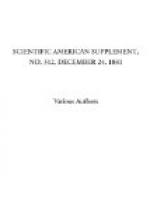For some time past it has been the desire of many photographers to have at hand a ready means of producing a powerful and highly actinic artificial light, suitable for the production of negatives, and easily controllable. Several forms of apparatus have been designed, and I believe have been, to a certain extent, employed successfully in portraiture. But it has been well known for many years that the electric light was just the light that would answer the photographer’s requirements, owing to its possessing great actinic power; but the cost of its production was too great for general adoption; indeed, such might be said of it now as far as dynamo-electric machines and steam or gas motors are concerned, for the majority of photographers. It is true that several influential photographers have already adopted the use of the electric light for portraiture, but the primary cost of the apparatus employed by these firms is far beyond the reach of most portraitists. The apparatus about to be described is one that has been carefully worked out to meet the wants of the photographer in almost every particular; in fact, with this apparatus, portraits can, and have been, produced in an ordinary sitting room, as good and as perfect as if taken in a well-lighted studio.
[Illustration: FIG. 1.]
The generator of the electric current consists of a series of voltaic elements of zinc and carbon—forty-eight in number—these elements being made up of ninety-six zinc plates and forty-eight carbon plates; thus the generator consists of forty-eight voltaic elements arranged in rows of twelve; they are all carefully screwed upon suitable bars of wood, and these bars are joined by other cross bars, which bind the whole in a compact form; the battery being suitably connected so as to produce a current of very high electro-motive force, and so arranged over their exciting trough that the plates can be raised or lowered at will, as seen in Fig. 1, which will explain itself almost at first sight.
The troughs are made of mahogany, put together with brass screws, and well saturated with an insulating compound which also makes them acid proof; the cells are charged with a saturated solution of bichromate of potash, to which has been added twenty fluid ounces of sulphuric acid to each gallon.
[Illustration: FIG. 2.]
To produce the electric current, all that is needed is to lower these suspended elements down into the trough, having previously connected the wires as shown in Fig. 1, to the electric lamp, Fig 2. At once a light starts up, between the carbon pencils, of a thousand-candle power or more. With a light of this power, a large head on cabinet or carte size plate may be produced in three or four seconds.
The generator occupies a floor space of three feet six inches by two feet, and stands two feet six inches high. The cells will cost 5s. to charge, and will produce upward of sixty negatives before being exhausted. All that is necessary, in recharging, is to lift the elements up out of the way, take out the troughs by their handles and empty them, charging them again by means of a toilet jug. When replaced, the whole apparatus is fit for use again; the whole of the above operation occupies but a quarter of an hour, and as there are no earthenware cells employed, there is no fear of breakage.




